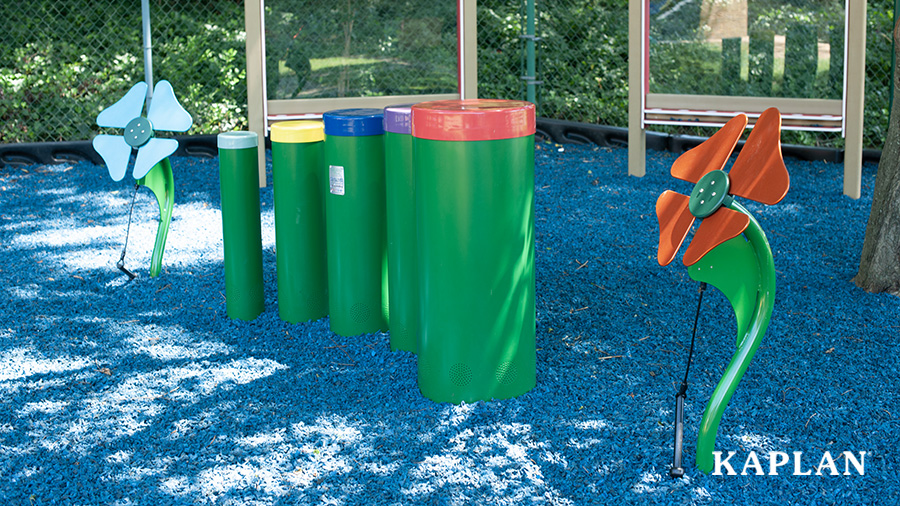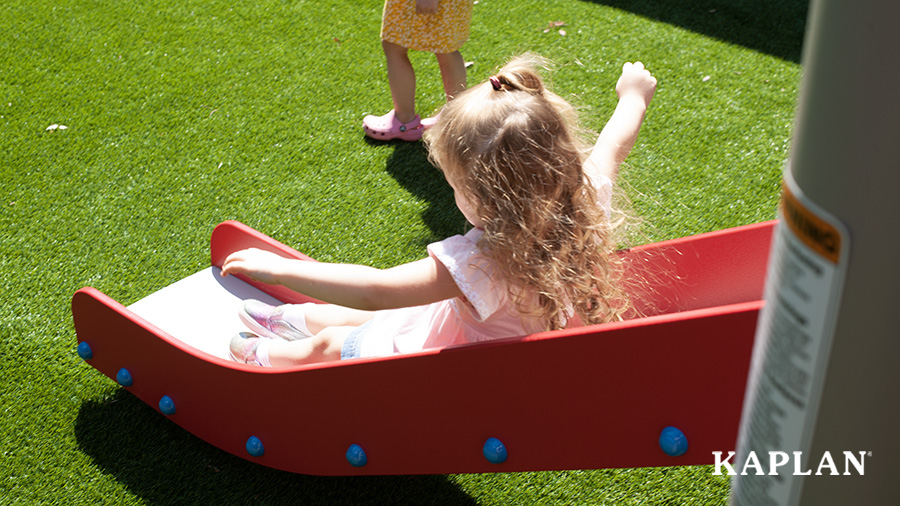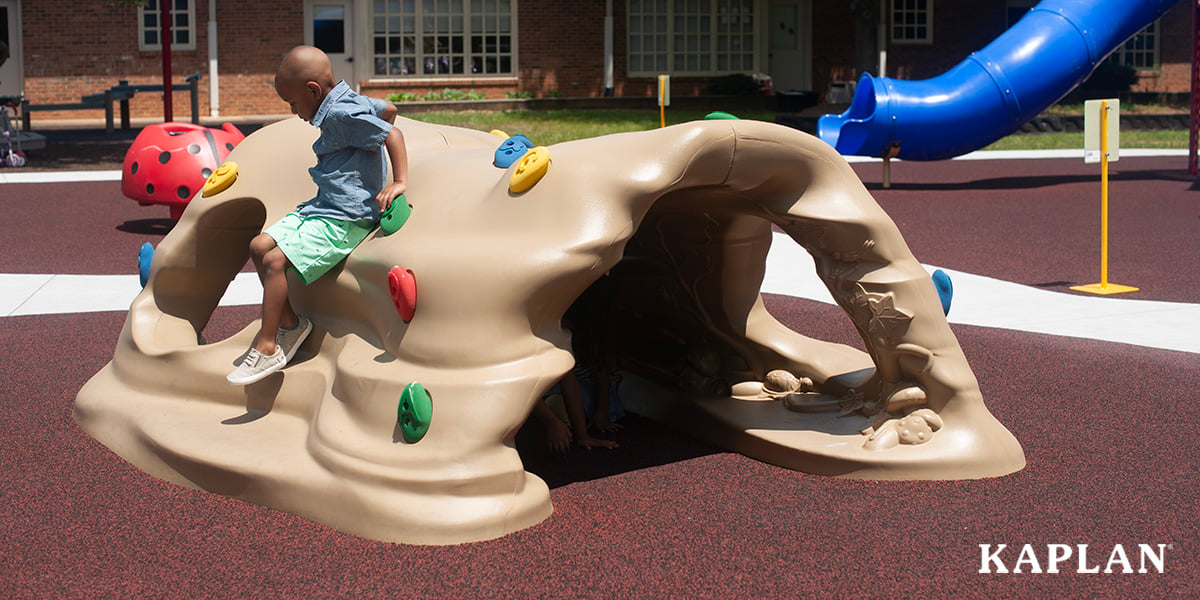As an educator, administrator, or someone else who makes decisions about the layout of a playground, you know that it is important to ensure the safety of the children in your care. You want to prevent injury wherever possible while also enabling them to play and have fun. If you are reading this article, you likely know that the type of surfacing you choose for your playground is an important part of ensuring both safety and fun. We have found that 75 percent of playground injuries happen because of falls onto inadequate surfacing, so getting good surfacing is especially important.
That said, it can be difficult to find the right kind of surfacing for your playground needs. There are lots of questions to answer: how much do the different types cost? Are certain types better for certain climates? What can I expect in terms of maintenance? Here at Kaplan, we have been building, designing, and installing playgrounds for decades, so we have extensive knowledge of the different types of safety surfacing available for playgrounds. In this article, we will give a brief overview of the different types of safety surfacing we offer and how much they cost as well as outline some factors that should influence your choice.
Different Types of Safety Surfacing for Playgrounds
The types of safety surfacing Kaplan uses fall into two general categories: loose-fill surfacing and solid surfacing. Loose-fill surfacing comes in two types of mulch: wood and rubber. It is known as “loose-fill surfacing” because the mulch has to be changed every 6-12 months, which means that the “fill” is “loose” since the original fill does not stay there for the whole life of the playground. Solid surfacing comes in four types of material: bonded rubber mulch, poured-in-place (PIP) rubber, synthetic turf, and rubber tile. Solid surfacing is known as “solid surfacing” because the original surfacing will last for many years and does not have to be changed with the same frequency as loose-fill surfacing. For more information on these types of safety surfacing, see another article about safety surfacing options on our website.

Cost and Warranty Information for Playground Surfacing
Generally speaking, loose-fill surfacing is less expensive than solid surfacing. Estimates for the cost of loose-fill surfacing range from $8-$12 per square foot, and estimates for the cost of solid surfacing range from $20-$28 per square foot (note: these cost estimates include materials and labor). In terms of budget, we recommend that you allot 40% of the money you plan to spend on a playground to safety surfacing.
Solid surfacing options have longer warranties than loose-fill surfacing options because loose-fill surfacing has to be replaced every 6-12 months. Here are some specific warranty ranges for each type of safety surfacing:
- Loose fill: 1 year for both wood and rubber mulch
- Solid
- Bonded rubber mulch and poured-in-place rubber: 3-5 years
- Rubber tile: 5-7 years
- Synthetic turf: 10 years.
When choosing between types of safety surfacing, it is important to consider cost in the long term. Loose-fill surfacing has a cheaper upfront cost but has a shorter warranty and requires frequent maintenance because the mulch needs to be changed every 6-12 months. Replacement mulch costs roughly $2-$3 per square foot. Solid surfacing costs more upfront but has a longer warranty and requires virtually no maintenance. The only maintenance you would have to do is clean it when things like pine needles or leaves get on it. In the table below, we show you how long-term mulch replacement can add to the original cost and how that compares to the cost of solid surfacing. We are basing these figures on a hypothetical 900-square-foot playground.
| Loose-fill Surfacing |
Solid Surfacing |
|
| Initial Cost Range (based on price estimates listed earlier) |
$7,200-$10,800 |
$18,000-$25,200 |
| Cost of Maintenance |
$1,800-$2,700 |
N/A |
| Total Cost after 5 Years |
$16,200-$24,300 (assuming you replace your mulch once per year) |
$18,000-$25,200 |
With these figures in mind, we encourage you to consider more than just the upfront cost. Think also about the kind of warranty you want and the amount of maintenance you want to finance.

Factors to Consider When Choosing Safety Surfacing for Playgrounds
Besides cost and warranty, there are some other things to keep in mind when you are trying to decide on the right kind of safety surfacing for your playground. The factors this section highlights do not apply to every kind of safety surfacing or every situation, but you should keep them in mind if specific circumstances or preferences in this section apply to you.
Age of the Children
We do not recommend loose-fill surfacing for a playground that children from 6 to 23 months old will primarily use. This is because there is a very high likelihood (perhaps a certainty!) that children this age will try to put pieces of mulch in their mouths. While any kind of solid surfacing will work fine for this age group, we especially recommend synthetic turf because it is the best surface for crawlers. It is the softest solid surfacing option, and it does not get as hot as other solid surfacing materials.
Surrounding Area
Rubber tile is only a good option if you are going to build the playground on top of concrete that is already there because rubber tile must be built on concrete. All other types of solid surfacing that we make are built on something called crushed stone aggregate, which is three times cheaper than concrete. So, if you do not already have concrete at the playground location you have in mind, it is probably best not to spend the extra money to install it.
Climate
Any rubber, solid surfacing option will not last as long in cold-weather climates as it would in warm climates. This is because the cold weather will cause it to contract, and small cracks and gaps will start to occur after a couple of years. For cold-weather climates, we specifically recommend synthetic turf or either type of mulch. Any of the six safety surfacing options would work fine in a warm climate.
Design Preferences
If you want to have a say in the way the surfacing is designed, we recommend poured-in-place rubber. This surfacing has lots of options for shapes, colors, and other design elements that you can select for your playground. All other types of surfacing pretty much come as they are, so you would not be able to shape their design according to your wishes.

Next Steps
We hope this article has given you some clarity about what type of safety surfacing is right for you. If you would like more specific information about the types of safety surfacing we offer, look at pages 62-64 of the digital version of Kaplan’s playground catalog. You can also reach out to the sales representative for your region if you want to talk to someone about any specific requests or needs you have. Here at Kaplan, we want to make sure you find the safety surfacing that is right for both your children and you!

